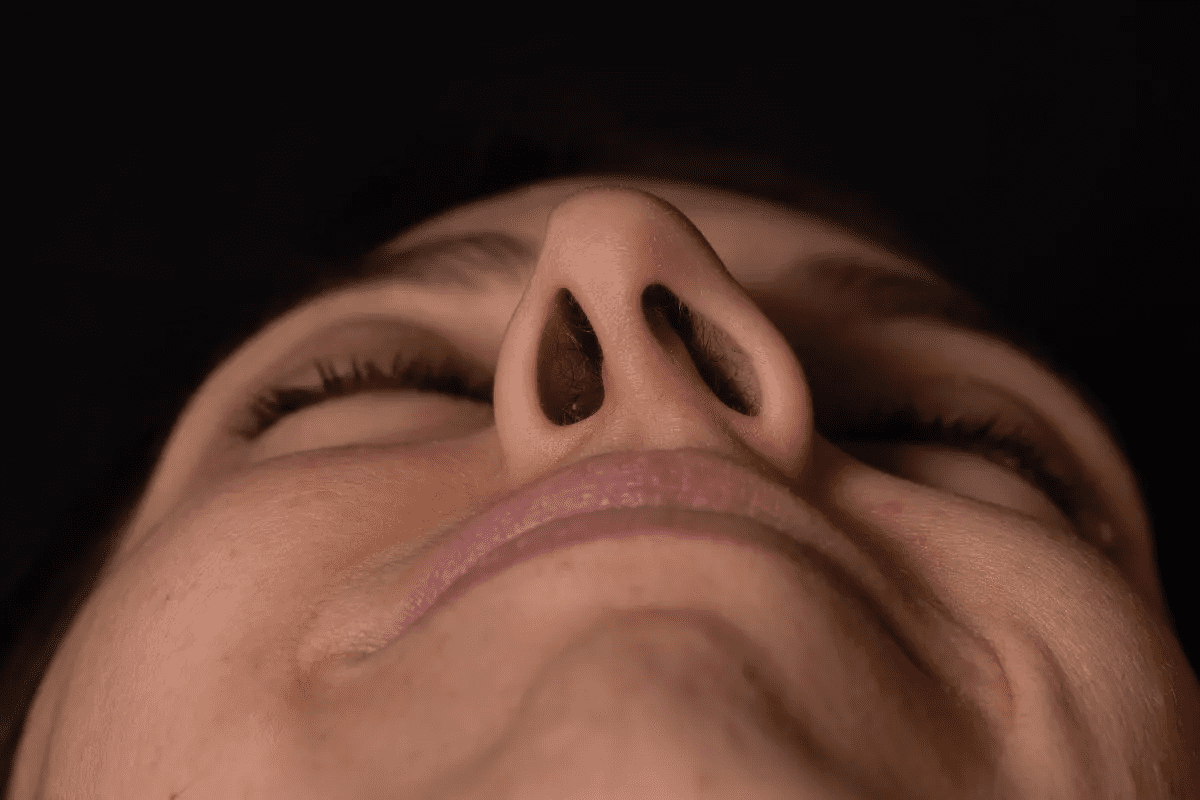Last Updated on November 27, 2025 by Ugurkan Demir

A deviated septum is a common issue where the thin wall between the nasal passages is off-center. It affects nearly half to three-quarters of people to some degree. Unlike allergies, which are caused by environmental allergens, a deviated septum makes breathing hard because of a physical blockage.
The causes of a deviated septum vary from being born with it to injuries. Studies show that about 47 to 75 percent of people have some degree of septal deviation.
It’s important to know the difference between a deviated septum and allergies for the right treatment. While allergies can make your nose stuffy, a deviated septum can cause more serious and lasting symptoms.
What is a deviated septum? Learn its causes (trauma, congenital) and how its symptoms differ from those caused by allergies.

The nasal septum is a thin wall made of cartilage and bone. It divides the left and right nostrils. Knowing about its structure and role helps us understand how issues like a deviated septum affect breathing.
The nasal septum has both cartilage and bone parts. It should be in the middle, splitting the nasal cavity into two. But, it can be off-center, which might affect how we breathe.
The nasal septum is key for breathing and nasal health. It keeps the nasal passages open and controls airflow. A deviated septum can block airflow, causing breathing difficulties.
Condition | Description | Impact on Breathing |
Normal Septum | Centered, dividing nasal cavity into two | Unobstructed airflow |
Deviated Septum | Displaced, potentially obstructing one nostril | Breathing difficulties, nasal congestion |
In summary, the nasal septum’s shape and position are vital for breathing. Problems like a deviated septum can cause big breathing issues. This shows how important it is to know about nasal anatomy.

A deviated septum happens when the thin wall between the nasal passages shifts. This makes one passage smaller than the other. It can cause breathing and nasal problems.
A deviated septum means the nasal septum is off-center. This can block the nose and lead to other issues. About 47 to 75 percent of people have some septal deviation.
The nasal septum is made of cartilage and bone. Its deviation can be caused by genetics, trauma, or developmental problems.
The severity of a deviated septum varies. It depends on how much the septum is off-center and how it affects breathing. Severity classifications help doctors choose the right treatment.
Knowing how severe the deviation is is key. It helps decide if treatment should be non-surgical or surgery.
The nasal septum’s deviation can come from prenatal issues or birth trauma. Knowing these causes is key to treating a deviated septum well.
The nasal septum starts forming early in pregnancy. But, many things can affect its growth, causing a deviated septum. These include:
Prenatal care is essential to lower risks. A healthy pregnancy can help avoid a congenitally deviated septum.
Birth trauma or complications can also lead to a deviated septum. The forces during birth can harm the nose’s delicate structures.
“Birth trauma can cause a deviated septum by displacing the nasal septum from its normal position.” – Dr. John Smith, ENT Specialist
The table below shows the causes and effects of congenital deviated septum:
Cause | Description | Effect |
Prenatal Development Issues | Genetic or environmental factors during fetal development | Deviated septum present at birth |
Birth Trauma | Physical forces during delivery | Nasal septum displacement |
Understanding these causes helps diagnose and treat a deviated septum early. This improves life quality for those affected.
Nasal trauma often leads to a deviated septum, affecting breathing and nasal function. Such incidents can change the septum’s shape, causing it to deviate.
Sports injuries are a big reason for nasal trauma. Contact sports like football, hockey, and basketball raise the risk of nose injuries. A hit to the nose can make the septum deviate.
Prevention is key in sports. Wearing protective gear, like face masks, can lower injury risk. But, accidents can happen even with safety measures.
Accidents and falls also cause nasal trauma and septum deviation. A fall or a car accident can damage the nose’s structure.
The severity of the deviation varies. Prompt medical attention is vital to check and possibly fix any septum deviation from trauma.
Physical fights or assaults can also lead to nasal trauma and septum deviation. A punch or blow to the nose can easily cause deviation.
People who have suffered nasal trauma should get medical help. Early treatment can avoid long-term problems from a deviated septum.
A deviated septum can cause many symptoms. These range from mild discomfort to severe health issues. It’s important to know these symptoms to get the right medical care.
Breathing difficulties are a common symptom. A deviated septum can block airflow, making it hard to breathe. This is worse during exercise or when you have a cold.
Doctors say breathing problems from a deviated septum can really affect your life. It can mess with your sleep, exercise, and overall health.
“Patients often report feeling like they can’t catch their breath or that they’re constantly congested.”
Nasal congestion and obstruction are also common. A deviated septum can make one nasal passage smaller. This leads to chronic congestion and stuffiness, making breathing hard.
A deviated septum can also cause recurring sinus infections. The abnormal airflow and pressure can lead to sinusitis. This causes pain, pressure, and discomfort in the face, along with nasal congestion and discharge.
It’s key to recognize these symptoms to get medical help quickly. Experts say a deviated septum is a common cause of sinus infections. Fixing the septum can help reduce these infections.
It’s important to know the difference between allergic rhinitis and a deviated septum. Allergic rhinitis is when your immune system reacts to things like pollen or pet dander. It affects millions, making life harder for them.
Your immune system fights off bad stuff. But with allergic rhinitis, it gets too excited about harmless things. This leads to symptoms like stuffy nose and sneezing.
It starts when something you’re allergic to gets into your nose. Your immune system makes IgE antibodies. These antibodies bind to the allergen, releasing histamine. Histamine makes your blood vessels bigger, causing more mucus and a stuffy nose.
Many things can set off allergic rhinitis. Here are some common ones:
Knowing what these allergens are helps manage allergic rhinitis. Staying away from them can make symptoms better.
Understanding allergic rhinitis helps manage symptoms. It’s key to know the difference from other nasal issues. This knowledge helps in finding the right treatment.
Both conditions can make it hard to breathe through your nose. But they have different causes and treatments. A deviated septum is a problem with the nasal septum’s shape. Allergies happen when your body reacts to certain things.
It can be hard to tell if you have a deviated septum or allergies because they share some symptoms. Symptoms of a deviated septum include:
Allergies usually show up with:
One big difference is when symptoms happen. Allergies often come and go with the seasons. For example, pollen allergies are worse in spring and fall. But a deviated septum’s symptoms are always there, no matter the season.
How well you respond to medicine also differs. Allergies usually get better with antihistamines, decongestants, and steroids. But a deviated septum might not get better with these medicines. Sometimes, surgery like septoplasty is needed to fix it.
Seeing a doctor is key to figuring out why you can’t breathe well. They can help you find the right treatment. Knowing the difference between a deviated septum and allergies helps you get better faster and live better.
To figure out if someone has a deviated septum, doctors use detailed physical checks and sometimes, imaging tests. It’s key to get the diagnosis right to pick the right treatment.
First, doctors do a physical check to spot a deviated septum. They use a nasal speculum to look inside the nose and see if the septum is off. This check can show if there are any issues like spurs or deviations.
The check might also include:
At times, imaging tests are needed to look closer at the nasal septum and the areas around it. Computed Tomography (CT) scans are great for checking the sinuses and spotting any issues like sinusitis linked to a deviated septum.
These tests give us detailed info on:
It’s important to tell a deviated septum apart from other issues that might cause similar symptoms, like allergies or sinusitis. We look at the patient’s health history, symptoms, and results from the physical check and imaging tests to make a correct diagnosis.
By using a full diagnostic approach, we can find the real cause of the symptoms. This way, we can create a treatment plan that works. By combining physical checks, imaging tests, and differential diagnosis, we can accurately find a deviated septum and help patients get better.
A deviated septum can be treated in different ways. This includes both non-surgical and surgical methods. The right treatment depends on how severe the deviation is, the symptoms it causes, and the patient’s health.
For those with mild symptoms, non-surgical treatments might be enough. This includes:
These methods can help some patients feel better. But they don’t fix the actual problem.
For more severe symptoms or blockages, septoplasty might be needed. Septoplasty is a surgery to fix the nasal septum.
The surgery involves:
After septoplasty, patients need time to recover. They might use medication and nasal care to manage nasal congestion and discomfort. Many patients see big improvements after septoplasty, such as:
Outcome | Description |
Improved Breathing | Fixing the nasal septum can make breathing easier through the nose. |
Reduced Sinus Infections | Improved drainage can lead to fewer sinus infections. |
Enhanced Quality of Life | Less nasal blockage and related symptoms can greatly improve life quality. |
It’s key for patients to follow their doctor’s post-op instructions well. This helps ensure the best recovery and results.
Having a deviated septum and allergies together can make symptoms worse. It’s hard for patients to find relief when both conditions are present.
When you have both a deviated septum and allergies, your nasal symptoms get worse. Nasal congestion is more severe, and the chance of sinus infections goes up. This is because the deviated septum blocks normal drainage, and allergies cause more swelling and inflammation.
Treating both a deviated septum and allergies needs a detailed plan. Septoplasty might be needed to fix the septum. At the same time, managing allergies is key, including avoiding allergens, using medications, and possibly immunotherapy.
By tackling both the deviated septum and allergies, we can greatly improve patient outcomes and their quality of life.
It’s important to know about deviated septum causes, symptoms, and treatments. This article has shown the differences between a deviated septum and allergies. We’ve looked at what makes each condition unique.
Getting a correct diagnosis is key to the right treatment. We’ve talked about different treatments, like non-surgical options and septoplasty surgery. It’s important for patients to get advice from a doctor for the best care.
Doctors can give better treatment by knowing the difference between a deviated septum and allergies. If you’re experiencing symptoms, see a doctor. They can help you find the best treatment for you.
A deviated septum is when the nasal septum is off-center. This can make breathing hard and cause other nasal problems.
A deviated nasal septum can happen at birth or from injuries. This includes sports injuries, accidents, and fights.
A deviated septum is a physical issue with the nasal passages. Allergies are an immune reaction to certain things. Their symptoms and treatments are different.
Signs include trouble breathing, stuffy nose, and frequent sinus infections. These can really affect your life.
Yes, for mild cases, you can try medications and lifestyle changes. But severe cases might need surgery like septoplasty.
To diagnose, a doctor will do a physical exam and might use imaging. This helps figure out the best treatment.
Seasonal symptoms usually mean allergies. Constant symptoms might mean a deviated septum or other issues.
Deviated septum symptoms don’t always get better with allergy meds. But, allergy symptoms can be helped by antihistamines and other treatments.
Yes, having both can make symptoms worse. You’ll need a treatment plan that covers both the physical and immune issues.
After septoplasty, you might feel some nasal stuffiness and discomfort. But most people can get back to normal in a few weeks, with better breathing.
It’s important to talk to a healthcare professional. They will look at how bad your septum is and other factors to find the best treatment for you.
Biro, P., & Hofmann, M. (2016). Physiological effects of preoxygenation in adults and children. Current Opinion in Anesthesiology, 29(4), 485-491. https://journals.lww.com/co-anesthesiology/Abstract/2016/08000/Physiological_effects_of_preoxygenation_in_adults.15.aspx
Subscribe to our e-newsletter to stay informed about the latest innovations in the world of health and exclusive offers!